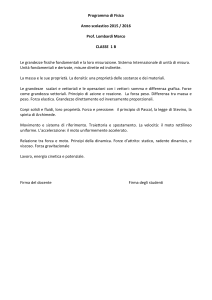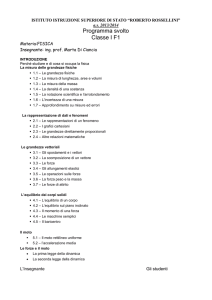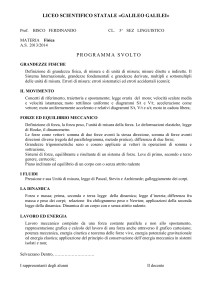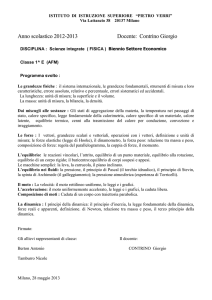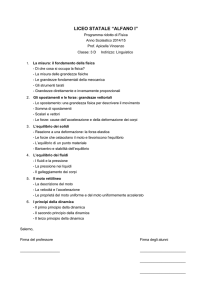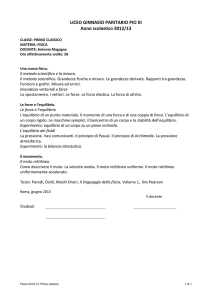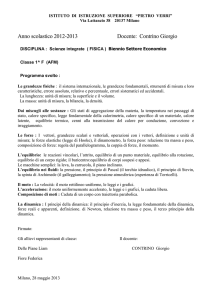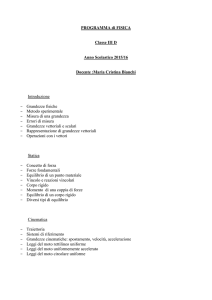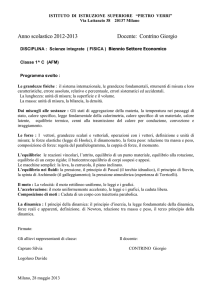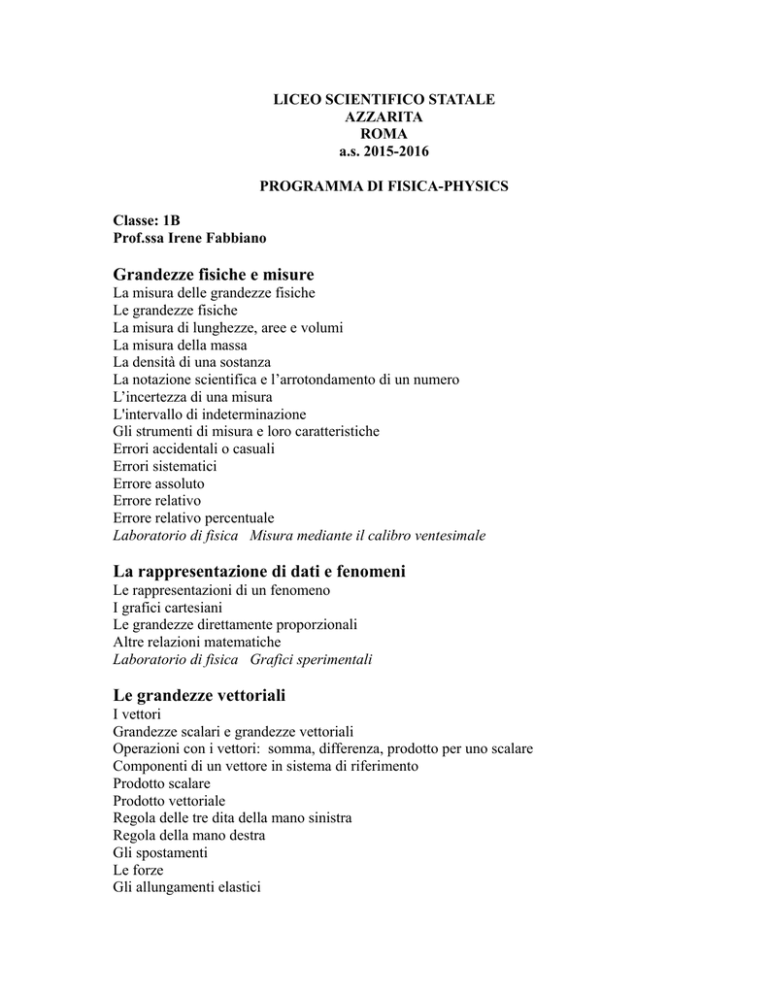
LICEO SCIENTIFICO STATALE
AZZARITA
ROMA
a.s. 2015-2016
PROGRAMMA DI FISICA-PHYSICS
Classe: 1B
Prof.ssa Irene Fabbiano
Grandezze fisiche e misure
La misura delle grandezze fisiche
Le grandezze fisiche
La misura di lunghezze, aree e volumi
La misura della massa
La densità di una sostanza
La notazione scientifica e l’arrotondamento di un numero
L’incertezza di una misura
L'intervallo di indeterminazione
Gli strumenti di misura e loro caratteristiche
Errori accidentali o casuali
Errori sistematici
Errore assoluto
Errore relativo
Errore relativo percentuale
Laboratorio di fisica Misura mediante il calibro ventesimale
La rappresentazione di dati e fenomeni
Le rappresentazioni di un fenomeno
I grafici cartesiani
Le grandezze direttamente proporzionali
Altre relazioni matematiche
Laboratorio di fisica Grafici sperimentali
Le grandezze vettoriali
I vettori
Grandezze scalari e grandezze vettoriali
Operazioni con i vettori: somma, differenza, prodotto per uno scalare
Componenti di un vettore in sistema di riferimento
Prodotto scalare
Prodotto vettoriale
Regola delle tre dita della mano sinistra
Regola della mano destra
Gli spostamenti
Le forze
Gli allungamenti elastici
Strumenti di matematica Il seno e il coseno di un angolo
Le operazioni sulle forze
Le forze di attrito: la forza di primo distacco e i coefficienti di attrito statico e dinamico
Laboratorio di fisica Verifica della legge di Hooke
Le forze e l’equilibrio
L’equilibrio dei corpi solidi
L’equilibrio di un corpo
Il piano inclinato
Il momento di una forza
Le macchine semplici
Le leve
La carrucola fissa
La carrucola mobile
Il verricello
Le coppie di forze
Il baricentro
Equilibrio stabile
Equilibrio instabile
Equilibrio indifferente
Attività Ricerca del baricentro di alcune figure realizzate in cartoncino
Il movimento dei corpi
Il moto rettilineo
Lo studio del moto
La velocità
Il moto rettilineo uniforme
L’accelerazione
Il moto rettilineo uniformemente accelerato
Il moto uniformemente accelerato con velocità iniziale
Il moto circolare uniforme
Il moto nel piano
Il moto circolare uniforme
La velocità angolare
Accelerazione centripeta
Le forze e il movimento
I principi della dinamica
Il primo principio della dinamica
Il secondo principio della dinamica
Il terzo principio della dinamica
Alcune applicazioni dei tre principi della dinamica
La forza centripeta
La forza gravitazionale
Il moto dei satelliti
L’equilibrio dei fluidi
La pressione
Il principio di Pascal
La legge di Stevino
Tecnologia Il freno idraulico e la pompa idraulica
I vasi comunicanti
La pressione atmosferica
La spinta di Archimede
PHYSICS
Length and time
Use and describe the use of rules and measuring cylinders to fi nd a length or a volume •
Use and describe the use of clocks and devices, both analogue and digital, for measuring
an interval of time • Obtain an average value for a small distance and for a short interval
of time by measuring multiples
Motion
Define speed and calculate average speed from total time total distance • Plot and
interpret a speed-time graph or a distance-time graph • Recognise from the shape of a
speed-time graph when a body is – at rest – moving with constant speed – moving with
changing speed • Calculate the area under a speed-time graph to work out the distance
travelled for motion with constant acceleration • Demonstrate understanding that
acceleration and deceleration are related to changing speed including qualitative analysis
of the gradient of a speed-time graph • State that the acceleration of free fall for a body
near to the Earth is constant
Mass and weight
Show familiarity with the idea of the mass of a body • State that weight is a gravitational
force • Distinguish between mass and weight • Recall and use the equation W = mg •
Demonstrate understanding that weights (and hence masses) may be compared using a
balance
Density
Recall and use the equation ρ = mV
Forces
Recognise that a force may produce a change in size and shape of a body
Effects of forces
Plot and interpret extension-load graphs and describe the associated experimental
procedure • Describe the ways in which a force may change the motion of a body • Find
the resultant of two or more forces acting along the same line • Recognise that if there is
no resultant force on a body it either remains at rest or continues at constant speed in a
straight line • Understand friction as the force between two surfaces which impedes
motion and results in heating • Recognise air resistance as a form of friction
Turning effect
Describe the moment of a force as a measure of its turning effect and give everyday
examples • Understand that increasing force or distance from the pivot increases the
moment of a force • Calculate moment using the product force × perpendicular distance
from the pivot • Apply the principle of moments to the balancing of a beam about a pivot
Conditions for equilibrium
Recognise that, when there is no resultant force and no resultant turning effect, a system
is in equilibrium
Centre of mass
Perform and describe an experiment to determine the position of the centre of mass of a
plane lamina • Describe qualitatively the effect of the position of the centre of mass on
the stability of simple objects
Scalars and vectors
Understand that vectors have a magnitude and direction • Demonstrate an understanding
of the difference between scalars and vectors and give common examples • Determine
graphically the resultant of two vectors
Momentum
Understand the concepts of momentum and impulse • Recall and use the equation
momentum = mass × velocity, p = mv • Recall and use the equation for impulse Ft = mv
– mu • Apply the principle of the conservation of momentum to solve simple problems in
one dimension
Roma,
Gli alunni
Prof.ssa Irene Fabbiano

